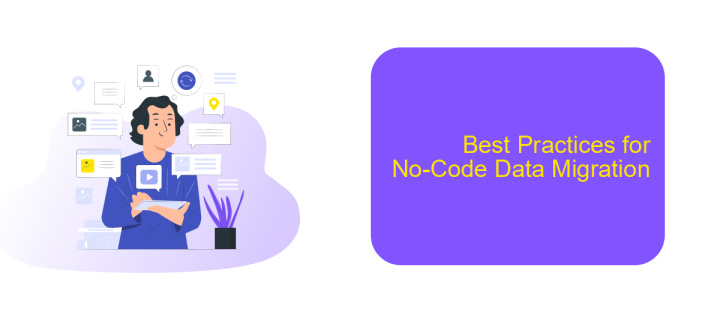No-Code Data Migration
In today's fast-paced digital landscape, businesses are increasingly seeking efficient ways to transition their data without the complexities of traditional coding. No-code data migration offers a streamlined solution, enabling organizations to transfer data seamlessly and quickly. This approach not only saves time and resources but also empowers non-technical users to manage data migration processes with ease and confidence.
Introduction to No-Code Data Migration
No-Code Data Migration has revolutionized the way businesses handle data transfer, eliminating the need for extensive coding knowledge. This approach empowers non-technical users to move data between systems seamlessly, saving time and resources. By leveraging user-friendly interfaces and automation tools, organizations can streamline their data migration processes without the complexities of traditional methods.
- Eliminates the need for coding skills
- Reduces time and cost of data migration
- Enables seamless integration between systems
- Minimizes errors and data loss
One notable tool in this space is ApiX-Drive, which offers a robust platform for setting up integrations effortlessly. ApiX-Drive allows users to connect various applications and automate data transfers with just a few clicks. This no-code solution ensures that businesses can maintain data integrity and continuity without the need for specialized IT skills. As a result, companies can focus on their core activities while ensuring their data is accurately and efficiently migrated.
Benefits of No-Code Data Migration

No-code data migration offers a streamlined approach to transferring data without the need for extensive coding knowledge. This method significantly reduces the time and cost associated with traditional data migration projects. By leveraging intuitive interfaces and automated processes, organizations can ensure a seamless transition of data with minimal disruption to their operations. Additionally, no-code solutions are often more accessible to non-technical staff, empowering a broader range of employees to participate in the migration process.
Another key benefit of no-code data migration is the ease of integrating various systems and applications. Platforms like ApiX-Drive enable users to connect diverse data sources effortlessly, ensuring that all necessary information is accurately transferred and synchronized. This capability not only enhances data consistency but also improves overall efficiency. By utilizing no-code tools, businesses can achieve faster deployment times, reduce the risk of errors, and maintain data integrity throughout the migration process, ultimately leading to better decision-making and operational performance.
How to Choose the Right No-Code Data Migration Tool

Choosing the right no-code data migration tool is crucial for ensuring a seamless and efficient transition of your data. Here are some key factors to consider when making your selection:
- Ease of Use: The tool should have an intuitive interface that allows users to perform data migration without technical expertise.
- Compatibility: Ensure the tool supports the data sources and destinations you need to work with.
- Scalability: The tool should be able to handle the volume of data you plan to migrate, both now and in the future.
- Security: Look for features that protect your data during the migration process, such as encryption and secure connections.
- Integration Capabilities: Tools like ApiX-Drive can facilitate seamless integration with various platforms, making the migration process more efficient.
By considering these factors, you can select a no-code data migration tool that meets your needs and ensures a smooth transition. Remember, the right tool can save time, reduce errors, and enhance overall productivity.
Best Practices for No-Code Data Migration

No-code data migration is an efficient way to transfer data without the need for extensive programming knowledge. To ensure a smooth migration process, it is essential to follow best practices that minimize risks and maximize efficiency.
Before starting the migration, thoroughly audit your data. Identify and clean any redundant or obsolete information to ensure only relevant data is transferred. This step helps in reducing the volume and complexity of the data being migrated.
- Choose the right no-code platform for your migration needs.
- Regularly back up your data before and during the migration process.
- Test the migration process with a small data set before a full-scale transfer.
- Utilize services like ApiX-Drive for seamless integration and automation.
- Ensure data security and compliance with relevant regulations.
Once the migration is complete, conduct a thorough validation to ensure data integrity. Verify that all data has been accurately transferred and that no critical information is missing. By following these best practices, you can achieve a successful and efficient no-code data migration.
- Automate the work of an online store or landing
- Empower through integration
- Don't spend money on programmers and integrators
- Save time by automating routine tasks
Case Studies and Success Stories
One notable success story comes from a mid-sized e-commerce company that needed to migrate their extensive customer database to a new CRM system. Traditionally, this would have required a dedicated IT team and several weeks of work. However, using a no-code data migration tool, they were able to complete the migration in just a few days. The intuitive interface allowed their marketing team to handle the migration themselves, reducing costs and minimizing downtime. This streamlined process enabled them to focus more on customer engagement and less on technical hurdles.
Another compelling case study involves a healthcare provider that needed to integrate patient records across multiple platforms. They utilized ApiX-Drive, a no-code integration service, to seamlessly connect their data sources. By automating data transfer and synchronization, they improved data accuracy and accessibility. This not only enhanced patient care but also significantly reduced administrative workload. The success of this integration project underscored the transformative potential of no-code solutions in complex, data-driven environments.
FAQ
What is No-Code Data Migration?
How does No-Code Data Migration work?
What are the benefits of No-Code Data Migration?
Can No-Code Data Migration handle complex data structures?
How do I ensure data security during No-Code Data Migration?
Time is the most valuable resource for business today. Almost half of it is wasted on routine tasks. Your employees are constantly forced to perform monotonous tasks that are difficult to classify as important and specialized. You can leave everything as it is by hiring additional employees, or you can automate most of the business processes using the ApiX-Drive online connector to get rid of unnecessary time and money expenses once and for all. The choice is yours!


